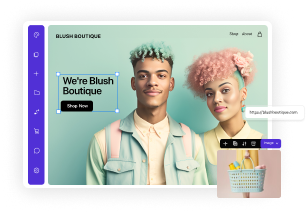How to Design the Perfect Website Under Construction Page in 2025
Updated Sep 26, 2025 | Published Sep 25, 2025 | 11 min read

Keeping your business website fresh and fully optimized is key to delivering the best experience for your customers. But when updates or design refreshes are underway, you don’t want to leave visitors in the dark.
That’s where an under construction page comes in. Done right, it shows your audience you’re improving their experience, keeps communication open, and reflects your brand in a positive light.
In this guide, you’ll learn how to design an under construction page for your website that not only informs but also builds trust, captures attention, and adds real value.
Under construction webpages have been around since the early days of the internet, but they remain as important today as ever.
Applicable to all types of websites, these pages offer numerous benefits to business owners in their marketing and promotional efforts.
Here are some reasons why setting up an under construction webpage matters to your online presence:
By including a temporary holding page, visitors can be assured that your business will resume normal operations in the near future.
Under construction pages serve a variety of purposes, but they aren’t always the best option depending on your situation.
Here are some factors to consider to help you decide if you need an under construction webpage on your website:
By thoroughly planning a website before its launch date, you can avoid the need for under-construction content.
You can also consider using a dedicated single landing page instead of a placeholder, which has the potential to offer more value.
Related read: Website design timeline.
Regardless of your business type, an optimized under-construction page should cover a selection of core features.
Here’s a breakdown of these key features to help you develop an effective website project plan:
While these features may change depending on your specific requirements, they’re commonly used on most under construction website templates.
We’ll break down each of these key features, along with optional extra content, in more detail throughout this guide.
Whether planning for maintenance or preparing a new product launch, an under construction page is necessary for business websites.
Follow these ten simple steps to design an under construction page that includes the essential information and links.
Before you begin compiling assets and text for an under construction page, you must be clear on the core messaging.
As with choosing a business name, this message should capture your business’s goals in a few lines of text and images.
If you’re site is undergoing maintenance, this message can be a straightforward announcement indicating when regular service will resume.
Alternatively, a concise message about new products will encourage interested visitors to stay tuned for further information.
Try to avoid dry corporate speak; instead, apply story-led messaging that connects with visitors on an emotional level.
You can then replicate and expand upon this message across your site’s other pages once it’s ready to go live.
Learn more: Top 25 e-commerce website examples.
With your core message determined, it’s time to start fleshing out the page’s design elements, ready to appeal to future customers.
Start by writing up a list of your business’s competitors and checking to see if any of their websites are using under-construction pages.
You can also use Google Image searches to find examples, tailoring your new design based on the results.
It’s essential to focus your research on relevant companies that align with your overarching business goals and customer base.
For example, marketing agency websites will typically use a different color scheme compared to entertainment or news sites.
Throughout this research, take notes on visual elements, text and descriptions, as well as how the page is used to generate leads.
Most up-to-date website builders provide extensive selections of templates that can be used to upload assets for websites.
This includes website under construction templates, available in multiple styles with options to customize to your liking.
Website builders feature business-related templates, ranging from templates for rental businesses to those for online shopping and entertainment.
By choosing one that closely matches your business, you can save time adding features and focus on making it look great.
It’s also worth visiting the best artist websites, as these place a heavy emphasis on presenting information with visual flair.
Once you’ve selected a website under construction template to work with, it’s time to start adding your company’s brand elements.
These elements include your company logo, as well as the color scheme and other branding elements used in your products or services.
Position your logo in a prominent location so it stands out when the page is loaded, such as the top banner on the left or right.
If you have bespoke icons for your business’s core features, including them will enhance the overall professional look.
Companies that have trademarked their name should ensure the ™ symbol is also included to affirm the trademark status.
Taking the time to select the best fonts for your website means little if the text itself isn’t correctly optimized.
Search engine optimization is a vital step for any business website, and should be applied to all text on an under construction page.
Many website builders include free SEO tools, often with an AI Assistant setting to suggest more reliable text.
You can also use third-party SEO tools to refine the wording of the messaging used on your website under construction page.
It’s a crucial step that will enhance your visibility and enable potential customers to discover your site through search engines.
In addition to high-resolution images and graphic design elements, your website under construction page can also use interactive media.
Animated elements that respond to mouse movements and other dynamic content can significantly improve the user’s experience.
This can include basic polls or quizzes, as well as interactive videos, infographics, and data visualizations.
Numerous website layout ideas incorporate interactive media, which you can reference when deciding what to include.
Once you’ve applied this media, check to see how it appears and functions on your company’s mobile website.
Placing a website under construction doesn’t mean you can’t use it as a method of communication with your customers and clients.
One way to maintain these channels is by including links to your social media presence on Facebook, Instagram, TikTok, and X.
Customers can then contact you to ask any important questions about your plans and to inquire about when business will resume.
This allows you to continue using social media platforms for marketing purposes, as well as for general customer support services.
While your maintenance is ongoing, you can utilize your social media channels to generate buzz and promote your website when it’s ready.
Collecting information from potential clients and customers is another core function that can be easily integrated into the page.
This can be through a basic email list or through an embedded sign-up form that adds contacts to your newsletter.
Once the emails have been collected, you can apply business automation tools to streamline your related outreach.
Read more: The ultimate guide to small business marketing.
As any marketing professional knows, promotions and early-bird discounts are reliably successful in generating buzz and word of mouth.
Offering discounts can increase your sales, and the under construction webpage provides an opportunity to push these directly to customers.
This can be particularly effective when the construction status is related to an upcoming product release, especially when FOMO is applicable.
You can further enhance its effectiveness by applying e-commerce SEO to ensure titles, text, and other content are optimized.
With trends indicating the need for e-commerce sites to adapt to the AI era, it’s worthwhile considering AI-powered live chat support.
Artificial intelligence has become an integral part of website design, and chatbots can be easily integrated into websites.
It can help engage passive visitors, answer common queries, and has the potential to generate consistent sales leads.
Read next: Website hosting cost guide.
Setting up an under-construction page is relatively straightforward, whether you’re using it on your own website or for a business.
Here are some essential tips and handy resources you can use to make your under construction page perform optimally:
If new information needs to be included, you can use your site’s fully customizable editor to update the design and text.
If your website is under construction or undergoing a redesign, a dedicated under construction page is essential. It reassures visitors, maintains trust, and ensures they know how to stay connected while you work behind the scenes.
By showcasing thoughtful design and including key information, your page can do more than inform; it can generate leads, build anticipation, and even drive sales.
With today’s easy-to-use tools, creating an effective under construction page is simple, and it’s a small step that delivers big value to your online presence.
